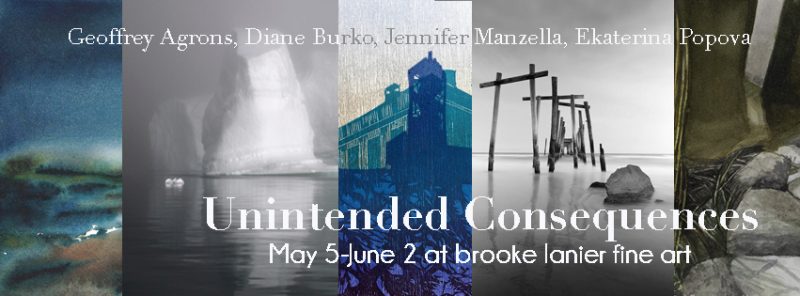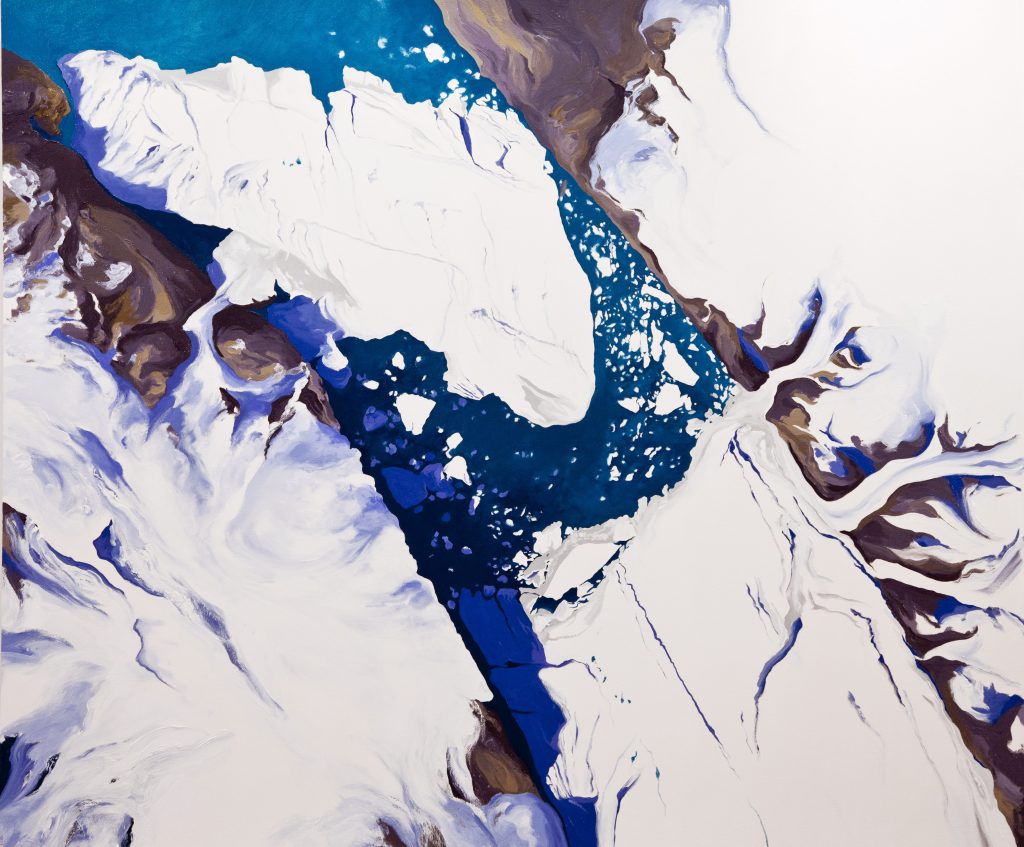Unintended Consequences
An Interview with Brooke Lanier by Paula Cahill
Unintended Consequences, May 5 through June 5, 2018
Opening Reception, Saturday, May 5, Noon to 3:00pm
Artist Talk, Tuesday, May 15, 6pm, Brooke Lanier Fine Art, 201 South Camac Street, 4th Floor, Philadelphia, PA
PC: I’m excited to see your upcoming exhibition, Unintended Consequences. Can you explain
how the images in Unintended Consequences relate to the landscape historically?
BL: I see these paintings and photographs as part of a larger art historical lineage that began in
the mid-1800’s and is still very relevant today. For instance, the Impressionists made paintings
that are now seen as merely pretty, colorful, and imbued with beautiful light, but if you look at
their subtext, the diffused light and color were caused by extreme air pollution from the
industrial revolution. Likewise, the landscapes in the show are quite beautiful and serene on the
surface, but they depict the continuing aftermath of industrialization and human impact on the
environment.
PC: How are the artists addressing climate change in Unintended Consequences?
BL: Jennifer Manzella’s prints of abandoned industrial building facades along the Delaware and Hudson Rivers are the first images viewers see when they walk into the show. They imply the environmental impact of industrialization. Diane Burko’s photographs from the Arctic Svalbard as well as Greenland’s Ilulissat Glacier and Ekaterina Popova’s watercolors of Skagaströnd, Iceland depict melting ice caps in the polar regions. Moving south, Geoffrey Agrons‘ photographs and my own watercolors depict shorelines destroyed by hurricanes and tropical storms. These are increasingly impactful, intersecting phenomena for densely populated coastal areas that are being developed at the same time that melting polar ice is causing sea levels to rise.
PC: How has climate change impacted your own work?
BL: I was making theoretical and abstract work until this past January when I visited my
grandmother in south Georgia. I had the opportunity to explore the coastline and marshes from southern Georgia to Jacksonville, Florida. Exploring eroded dunes in terrifyingly disorienting fog and tromping as close to the edge of the salt marshes as I could get without sinking in, I witnessed the destruction, change, and extreme erosion that hurricanes and tropical storms have wreaked onto the landscape during recent years.
I began to focus on the environmental impact of these events and the interaction between human destruction of the wetlands and the development of desirable beachfront communities. To accommodate mass development of coastlines, flood plains and wetland areas were paved over, decimating an important source of natural flood control. An ever increasing coastal population means that the impact of the storms on humans is much greater since so many people lose their homes and businesses. After seeing the immense impact of the hurricanes, I came back to Philadelphia and completely changed what I was making.
PC: It sounds like you had a deeply moving response to this experience and that your work
became more personal as well as more focused on social and environmental change.
BL: Yes.
PC: What would you like people to take away from Unintended Consequences?
BL: These images deal with the beauty in the details, but they evoke the sublime: a feeling of
being very small in the face of something very immense and powerful like a storm, the climate,
or how tiny one is compared to a glacier. I hope the viewers will think about their place in the
universe.
*For more information: Brooke Lanier Fine Art or brooke.lanier@gmail.com
Unintended Consequences https://www.facebook.com/events/1480508215410781/
Landscapes are a physical history of events that shaped them. In this exhibition, Geoffrey Agrons, Diane Burko, Brooke Lanier, Jennifer Manzella, and Ekaterina Popova raise questions about what events transpired that shape our current environment. The poetically unpopulated vistas in this exhibition subtly imply the lingering unintentional effects that humans have had on our planet in the wake of industrialization. Rather than being overly clinical or didactic, these images function as personal experiences of global phenomena.
Jennifer Manzella’s prints depict deserted urban landscapes, including vacant lots and derelict industrial buildings along the Hudson and Delaware Rivers. These structures, geometrically simplified silhouettes, have been forgotten in the wake of the decline of the American manufacturing industry. The empty spaces in her compositions are equally important as the vacant buildings.
Similarly, Geoffrey Agrons’ photographs feature mysterious structures such as the bones of piers along coastlines devastated by hurricanes. In much architecture there is an implicit assumption that we have dominion over our surroundings, but nature is unconquerable. Agrons has said that he only points his lens at something that breaks his heart, and indeed, there is a sense of melancholy and being lost in a vast space, trying to make sense of the aftermath.
The coastal areas in Brooke Lanier’s watercolors have been hit by multiple hurricanes in the past two years. Destruction of wetland wildlife habitats for real estate development exacerbates recurrent flooding. As warming oceans and melting glacial ice raise water levels, flooding from tropical storms has an increasingly devastating impact on highly populated coastal areas. Property highly sought after by vacationers and retirees is vulnerable to extreme weather. Carefully landscaped beaches are reshaped by storms and strewn with rubble.
Diane Burko’s photographs give a face to statistics, documenting of the regression of glacial ice. Burko accompanied climatologists to the Arctic Svalbard as well as Greenland’s Ilulissat Glacier to document the shrinking of polar ice over time. Her work contains an inquisitive quality that is also present Ekaterina Popova’s watercolors of Skagaströnd, Iceland. These images serve as visual proof, used for sharing a story once their creators return home.
The show is open to the public Tuesday through Friday 12 p.m. to 5 p.m., Saturday 10 a.m. to 2 p.m., and by appointment. A brunch opening will be held on May 5th from 12 p.m. to 3 p.m. Join us for coffee, muffins, and conversation with the artists.
Thank you to Paula Cahill for the interview with Brooke Lanier. Extra content copied from the facebook event page.
Like DoNArTNeWs Philadelphia Art News Blog on facebook
Follow the new DoNArTNeWs.com
Follow DoN on Twitter @DoNNieBeat58
@donniebeat on Instagram
Affiliate Marketing [disclosure page] Shop on-line and help support DoNArTNeWs
Donate via safe and secure PayPal in the sidebar.
DoNArTNeWs – celebrating ten years reporting on Philadelphia artists and art.





